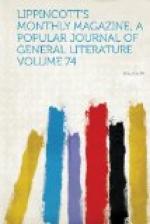[Illustration: The Tiber, from Orte.]
[Illustration: Borghetto.]
[Illustration: St. Peter’s and the Vatican, from the falls of the Tiber.]
The Tiber, winding as it does like a great artery through the heart of Rome, is seldom long either out of sight or mind. One constantly comes upon it in the most unexpected manner, for there is no river front to the city. There is a wide open space on the Ripetta—a street which runs from the Piazza del Popolo, at the head of the foreign quarter, to remoter parts—where a broad flight of marble steps descends to the level of the flood, and a ferry crosses to the opposite bank: looking over at the trees and fields, it is like the open country, yet beyond are St. Peter’s and the Vatican, and the whole of what is known as the Leonine City. But one cannot follow the Tiber through the streets of Rome as one may the Seine in Paris: in the thickly-built quarters the houses back upon the stream and its yellow waves wash their foundations, working wrath and woe from time to time, as those who were there in the winter of 1870 will recollect. Sometimes it is lost to sight for half a mile together, unless one catches a glimpse of it through the carriage-way of a palace. From the wharf of the Ripetta it disappears until you come upon it again at the bridge of St. Angelo, the AElian bridge of ancient Rome, which is the most direct passage from the fashionable and foreign quarter to the Trastevere. It must be confessed that the idle sense of mere pleasure generally supersedes recollection and association after one’s first astonishment to find one’s self among the historic places subsides; yet how often, as our horses’ hoofs rang on the slippery stones, my thoughts went suddenly back to the scene when Saint Gregory passed over, chanting litanies, at the head of the whole populace, who formed one vast penitential procession, and saw the avenging angel alight on the mausoleum of Adrian and sheath his sword in sign that the plague was stayed; or to that terrible day when the ferocious mercenaries of the Constable de Bourbon and the wretched inhabitants given over to sack and slaughter swarmed across together, butchering and butchered, while the troops in the castle hurled down what was left of its classic statues upon the heads of friend and foe, and the Tiber was turned to blood!




